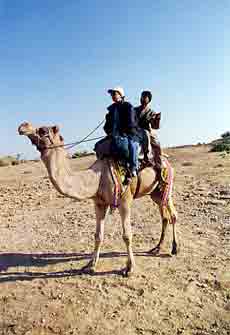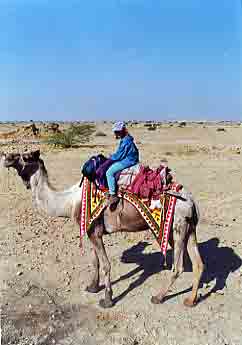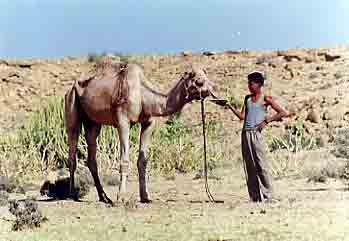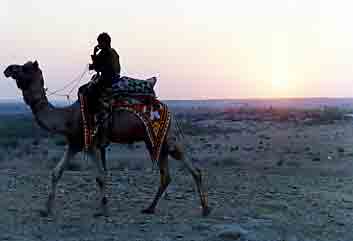|
|
|
|
Camels Across the Thar
George
|
|
|
|
|
|
|
 Salli and her camel driver scan the desert and route ahead Salli and her camel driver scan the desert and route ahead
|
|
I leaned back, stretching my legs across the warm sand and resting my head on the frame of the camel saddle. Despite the fact it was early January the afternoon sun was intense, enough to make our four camels listless and the scorpions run for cover.
All of us, our family and our four camel drivers were taking an afternoon break after our five hour camel ride from a village outside of Jaisalmer. We had stopped in a rocky bowl, sheltered from the winds. One gnarly tree provided a spot of shade in which all of us crowded. Mughal, our lead driver, built a fire of camel dung and twigs against this tree and we all joined in the work: cleaning the pots and chipped enamel plates with sand, slicing vegetables, mixing the tea.
We ate the spicy food using our right hand and bread to scoop, sipped the tea, and then took turns making certain the camels got their share of the sparse local brush, the thorny babool. And then we all, two leggeds and four leggeds relaxed. Mughal and his "boys" played cards. We wrote in our journals, took photographs, napped, listened to the million flies, bees and birds, and marveled at where we were.
We were near the heavily armed border of Pakistan, in the western Thar Desert of Rajasthan, a region of nearly 200,000 square kilometers. On one horizon, past the heat mirages, we could make out where we'd started. A flat topped hill with
|
|
|
|
steep slopes rose from the desert floor. On this sprawled a golden city-fort, surrounded by steep, sheer double-walled ramparts. Inside was a kingdom that looked dream like, a Lucas film set for a remake of Tales of the Arabian Nights. Over 300 feet above its base, tall minarets and 99 bastions cast dark shadows across the ornately carved sandstone palaces and havelis, or mansions. All of this carved from large blocks of yellow sandstone, hence the appropriate term for the city of Jaisalmer, the "Golden City."
Lying there in the sun after our camel ride, looking through the heat mirages at the golden city-fort, it was easy to lose ourselves in the magic and wonder of it all. We'd come all this way, several days and harrowing nights on express trains and daredevil busses to ride camels and learn about them. And instead we got much more. This is the way of India, you're always getting far more or far less than you bargained for.
But in those warm moments what we had gotten was clearly on the plus side. Earlier, before dawn, our drivers and their animals arrived at our desert hut. Commands were shouted to the animals and in unison they all fell. Camels don't sit, they fall, like Newtonian apples, only in jerky stages. First their fronts down to their knees, then their rears, then the front again, and finally the tail end. Down until their backs are about high enough for me to swing my legs over and sit down. The rest of the family had to climb or be hoisted.
|
|
 Cassidy prepares for the race Cassidy prepares for the race
|
|
|
|
Once aboard more commands were shouted, and suddenly we each grabbed on for our lives, Salli and Cassidy shouting in panic. A camel standing is an acrobatic feat--for the camel that is. For the rider it's more akin to riding the prize winning Brahman bull for eight seconds in the rodeo. The rear skyrockets popping you at a dangerous and not so kind angle, then just as suddenly the front end snaps upwards pitching you backwards. And just when you thought that it was amazing you stayed on, the rear pops the next stage and the front pistons still higher. And once up, a camel is ready to go, in any direction, usually with a loud snort while you're still hanging on.
|
|
|
|
Oh, snorting. There's this funny thing about camels at the time of year we rented ours. As near as we could make out from the pidgin English of our drivers, it seems these noble beasts of burden stop eating for a month and busy themselves with territorial battles, courting rituals and tongue bloating. The first two of these I remember from high school, but the last one was something new.
You're riding along on your ship of the desert, rocking forward and back, getting slowly hypnotized by the graceful arches of the camels neck as it leads each step, then suddenly out of the corner of its mouth a large bubble of pink and blue bladder swells. It looks like Bazooka Bubble Gum came out with a new flavor, Texas Chainsaw Massacre Tutti Fruti. The bubble continues to inflate, growing nearly as large as the head.
|
|
 The camels get their share of the lunch as well The camels get their share of the lunch as well
|
|
|
When this first happened I was convinced my camel was turning himself inside out. (Remember, you read it here first, even before Ripley's Believe It Or Not!) And then it bellows, quivering and undulating and making weird gurgling sounds. This is some sort of camel talk apparently because the others immediately join in the chorus.
And then the tongue slips back inside and we jaunt our merry way across the desert.
The early morning air was still cold. We all wore coats and hats and our drivers were swathed in their wool blankets. Our first destination was to the village where Mughal lived with his father and family. Twisting lanes, or rather camel tracks led us past low rock shelters, out of which children and mothers were just rising. We stopped to water our camels as the sun was beginning its morning duty of warming the earth. Crows gathered around the scene expecting some part of the breakfast.
Once watered we traipsed out of the village, first along a paved road on which an occasional military vehicle sped. (BTW: did I mention that India is a country which can't make a electricity last for more than two hours, can't run a bus without incident, and can't even make a toilet that works. Yet it has a bunch of A-bombs to play with. Makes you kinda queasy, if you know what I mean).
We rode through the morning, stopping once at an ancient ruin, the graveyard of a past Raja's many harem wives. And before long we were at our mid-day lunch spot, enjoying the shade of the tree and the rock-steady feel of the earth beneath our bums.
The respite went by slowly, the sun dipped a degree or two, enough that the shadows of the tree moved, and it was time for us to push on. Saddling up the camels with brittle hemp ropes, throwing on the layers of thick wool blankets on the wooden saddle frames, and mounting our steeds for one more rocket into space, we were off.
We crossed a rocky ridge and slid down into a long, dry canyon. We rode along for an hour or two, rocking forward and aft, saying nothing, marveling over the occasional bubble of tongue, when Mughal decided we were OK riders, good enough to race.
My camel, named Durrie, was the clearly the Alpha camel. All day he refused to allow any other camel to get in front of him, and now that we picking up the pace, Durrie was determined to remain in front. When Samantha's camel, Raj slipped by on an inside corner, Durrie picked up his pace. And when we were one step behind, Durrie stretched out his neck and bit Samantha's camel hard in the, well, the last part to go over a fence. Hard enough to cause blood to spurt and a camel to shout out across the desert. Raj got the message and slipped behind, and Durrie proudly resumed setting the pace for our racing family.
At the end of the day, after exploring two more ruins, we wound our way back to a hill outside Jaisalmer to watch the sunset. We got off our camels and sat on the rocky slopes watching a giant red glowing sun sink across distant Pakistan. Immediately the air cooled and the camels became restless. Durrie inflated his tongue and let out a final day's gurgle, and we mounted for our final ride back to our hut, and back to our journals where we'd write about this most incredible experience--our day on the Thar Desert on camels.
And Mughal and his boys returned to their rock homes, to put their camels away, and to dream of another day--their day on the Thar Desert. |
|
|
|
 |
|
|
|
|
|
|
|
|
|
|
|
|
|
|
|
|
|
|
|
|
|
|